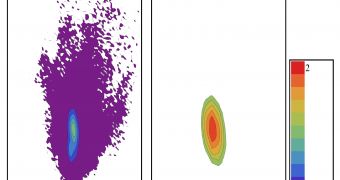US National Institute of Standards and Technology (NIST) scientists announce the development of improved optical tweezers, devices that can manipulate nanoscale particles by using a beam of light.
The reason these instruments are called tweezers is that they act with pinpoint accuracy, grappling nanoparticles and then moving them to wherever they are needed. This is usually done by suspending the tiny structures in a solution and then shining a powerful laser beam inside.
What the light does is create a potential well, a strong electrical field that attracts the nanoparticles towards it. At the same time, the molecules making up the solution in which the particles swirls tend to push the latter out of the well.
This interplay between the influences of laser light and the solution itself is largely what determines the length of time for which the nanoparticles can be trapped by the tweezers. Also, smaller particles are more difficult to attract using laser light of the same intensity.
One way to increase the lifespan of trapped nanoparticles is to boost the intensity of the light trapping them, but this can damage both the solution and the particles, and is unfeasible for practical applications. Scientists plan to use optical tweezers for treating conditions such as cancer soon.
But working inside biological cells is an extremely complex task, since the material is very susceptible to damage, especially from strong lasers. In the new research, NIST investigators have created an optical tweezer that is capable of holding on to nanoparticles longer, but at lower laser intensities.
This was done by putting together a control and feedback system that is capable of acting on the trapped nanoparticles only when needed. This decreases the average intensity of the laser beam over time, while at the same time increasing the useful lifespan of the particles.
In turn, this gives investigators more time to manipulate the small structures. They can create 3D structures, or force the particles to come together in specific patterns that could then be used to target diseased cells, or for other applications. The new tweezers provide a ten-fold improvement in time.
“You can think of [the new tweezers] like attracting moths in the dark with a flashlight. A moth is naturally attracted to the flashlight beam and will follow it even as the moth flutters around apparently at random,” Thomas LeBrun explains.
“We follow the fluttering particle with our flashlight beam as the particle is pushed around by the neighboring molecules in the fluid. We make the light brighter when it gets too far off course, and we turn the light off when it is where we want it to be,” the expert adds.
“This lets us maximize the time that the nanoparticle is under our control while minimizing the time that the beam is on, increasing the particle's lifetime in the trap,” concludes the expert, a research physicist with the NIST Physical Measurement Laboratory (PML) Semiconductor & Dimensional Metrology Division's Nanoscale Metrology Group.

 14 DAY TRIAL //
14 DAY TRIAL //